#wildfires
Text

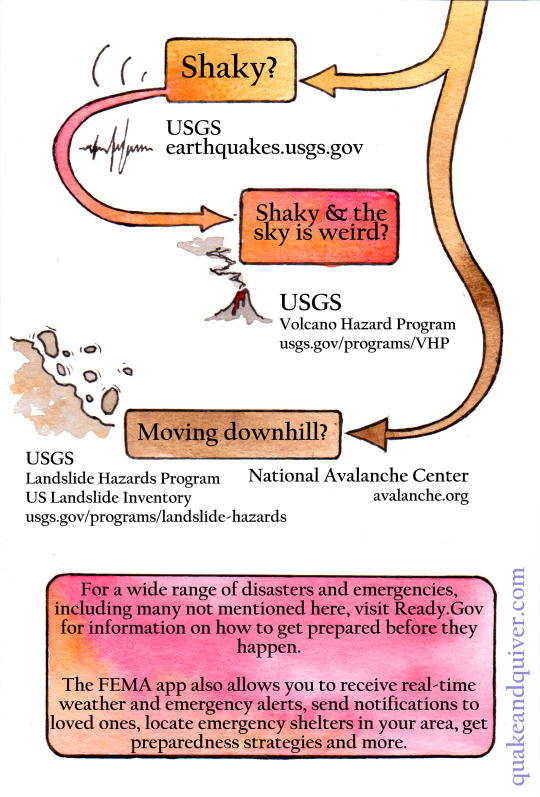
Noticed something a little funky in the world around you and want to figure out what's up? Especially if there might be something you ought to be doing about it? Not sure what information sources to trust these days? If you're in the US, federal agencies like NOAA, USGS, EPA and more collect massive amounts of scientific data every day, much of which is publicly available online - if you know where to look.
A PDF version with clickable links is available for free on my itchio page (quakeandquiver); I'll add a direct link in a reblog.
#wildfires#earthquakes#volcanoes#flooding#natural hazards#disasters#sketchpad#risk comm#environment#disaster preparedness
24K notes
·
View notes
Text
If you're in an area that is suffering from wildfire polluted air, I just saw this on Twitter:
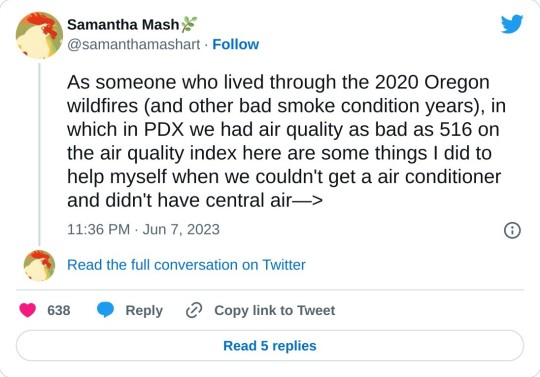







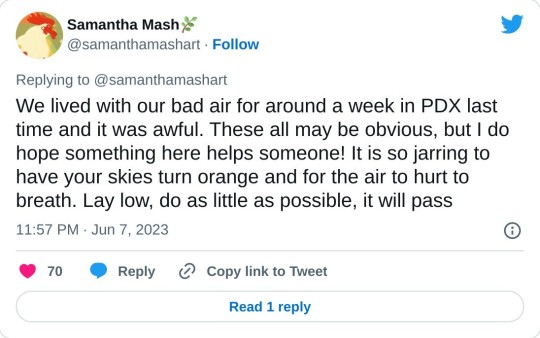
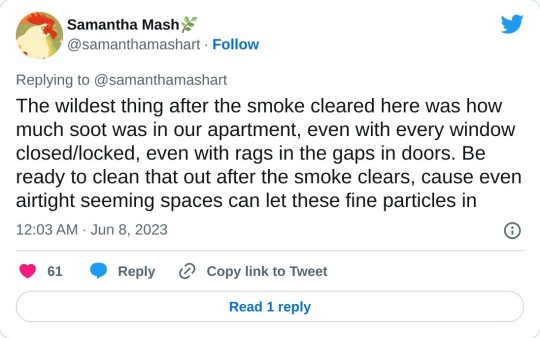
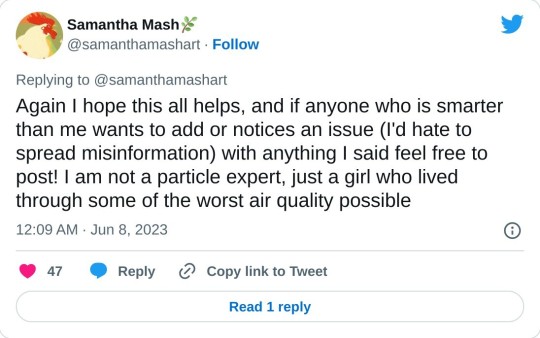
Bonus:
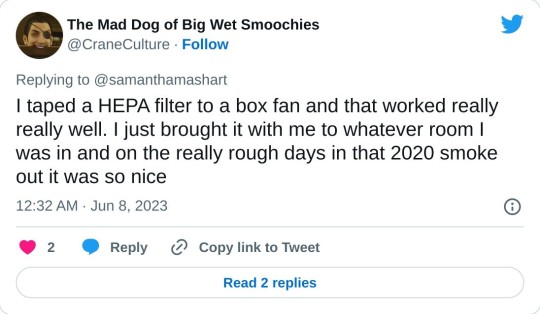
Here's a site I found that can tell you how to make these:
Edit: There have been some extra pointers (about open sources of water in the home, and I believe some other things) in the reblogs, so I highly recommend taking a look at the notes of this post!
Also: Cloth masks are NOT sufficient. Use KN95s or N95s!
#hepa filter#diy air cleaner#wildfires#new york#wildfire safety#samantha mash#(I can't believe i forgot to put her in the tags!)
18K notes
·
View notes
Text
Hi! Just wanna raise some awareness here because South America is on fucking fire and I need to see more people talking about this.

Source: RSOE EDIS x
Im just going to talk about the ones i'm closest to, but if you know about these fires, feel free to add in the reblogs!
Chile
In Chile there's (up to Feb 5) 160 wild fires, of which 40 are still trying to be controlled by authorities. The president, Gabriel Boric, has declared State of Emergency in the whole country, and theres a Red Alert Code in most part of the country.
Isla de Chiloé, Southern Chile (900 km away from Santiago de Chile)
This is a (recently controlled) fire that lasted a week, but many neighborhoods were burnt to the ground.
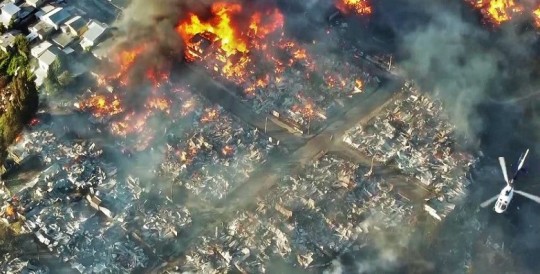

The whole South is in red alert for constant sudden fires that spread quickly due to the lack of rain and the elevated temperatues in the zone. Just today, two fires had to be controlled in the main land next to this island, and more are being reported in the Los Lagos region. This is added to the "controlled" intentional fires that farmers make to clean their fields of old crops along the Central-South parts of the country, mostly surrunding the main route, Ruta 5, that connects the whole country, thus making it hard to see and breathe because of the smoke. (flashnews, most of them get out of control quickly.)
Valparaiso/Viña del Mar, Central Chile (100 km away from Santiago de Chile)

A fire that started on Friday 2nd and grew exponentially because of the wind and the dry, hot climate. More than 100 people are dead, with 70 unrecognized bodies and other 400 that have dissapeared. At least 30000 people that have lost everything to the fire.
There's massive evacuations from this and the neighboring city, Viña Del Mar.
This is said to be the second most deadly fire in the century, surpased by Australia in 2009.
45000+ hectares that include land and neighborhoods have been burnt down.
I could go on about this one, so more info here and here
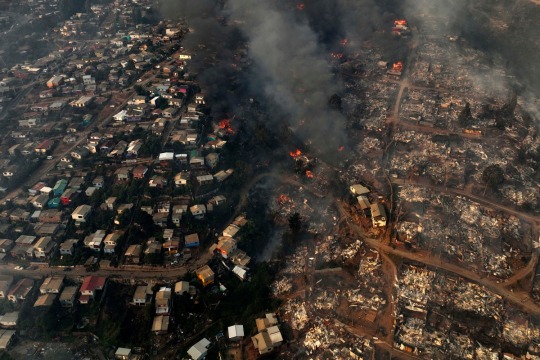

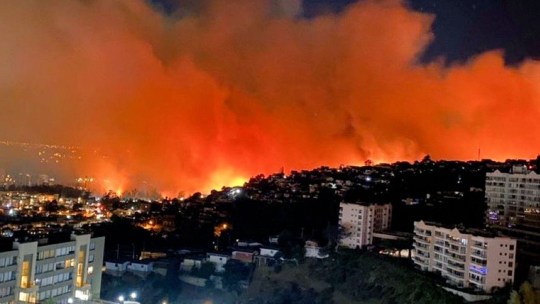
Argentina
Parque Los Alerces (Esquel), Chubut
The fire strarted on the 25th January, and the climate has made it hard to contain. 3000 hectares of native forest have been burnt to teh ground. It is now growing in the direction of the nearest city, Esquel. Theres been evacuations between yesterday and today (4 and 5th Febuary)

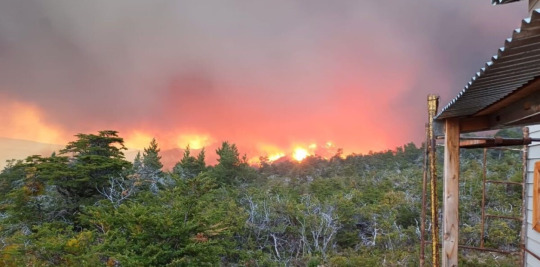
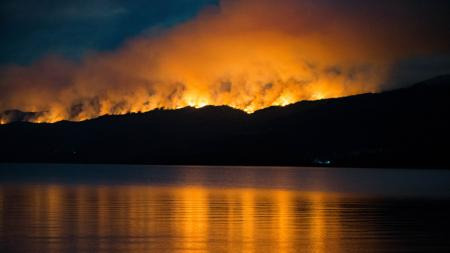
Parque Nahuel Huapi (Bariloche), Río Negro
The reason why im writing this. The city woke up today covered in smoke after a wildfire developed yesterday during the night. The reason? A fireplace that was not turned off in a place where people cannot disembark and can only be reached via boats.
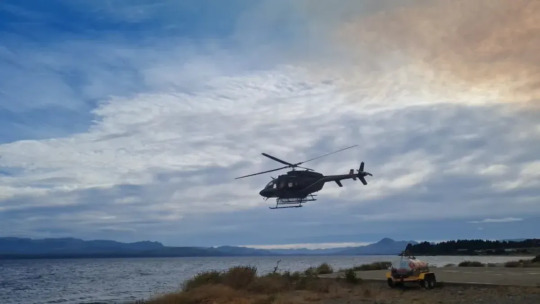


As of now, there's not much information about the fire but hopefully the firefighters will be able to contain it before it reaches Tronador Mountain, where an ancient glaciar is.
...which leads me to the other point i wanted to talk about.
Firefighters
They volunteer to do this job.
In Argentina and Chile, firefighting is not rewarded with a salary, and most of the times they dont even have full firehouses to stay in. These people are at their houses, ready to jump into action and run to the station the second the alarm goes off.
They are neighbors, people that risk their lives and run into danger willingly, just because they want to help the community.
I felt the need to give a shout-out to these people and say:
Don't be a fucking dick, don't start fires in the woods unless it's an approved place, and if you do, TURN IT OFF.
Pour abundant water on it, and do not stop when you don't see any more flames.
Keep pouring water until the ashes don't burn/feel like room temperature in your hand if you put it 10 cm away from it, and even then, pour some more just to be sure.
No heat and no smoke mean a safely extinguished fire.
Save lives and forests.
#dont even get me started on the denial of climate change from my president#didnt wanna get political here#argentina#chile#argieposting#argieblr#soff speaks#wildfires
6K notes
·
View notes
Text
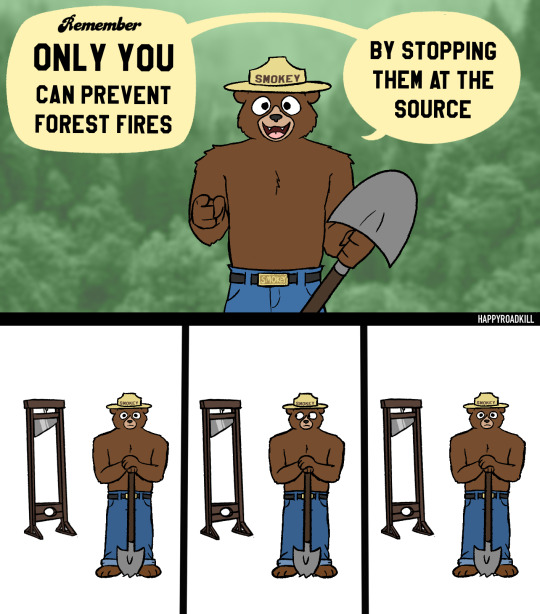
what did he mean by this
#comic#art#cartoon#environment#wildfires#wildfire smoke#solarpunk#politics#sociology#east coast#artists on tumblr#smokey the bear
20K notes
·
View notes
Text
Greenwashing set Canada on fire
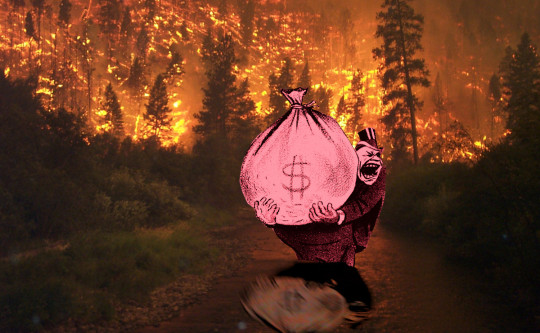
On September 22, I'm (virtually) presenting at the DIG Festival in Modena, Italy. On September 27, I'll be at Chevalier's Books in Los Angeles with Brian Merchant for a joint launch for my new book The Internet Con and his new book, Blood in the Machine.

As a teenager growing up in Ontario, I always envied the kids who spent their summers tree planting; they'd come back from the bush in September, insect-chewed and leathery, with new muscle, incredible stories, thousands of dollars, and a glow imparted by the knowledge that they'd made a new forest with their own blistered hands.
I was too unathletic to follow them into the bush, but I spent my summers doing my bit, ringing doorbells for Greenpeace to get my neighbours fired up about the Canadian pulp-and-paper industry, which wasn't merely clear-cutting our old-growth forests – it was also poisoning the Great Lakes system with PCBs, threatening us all.
At the time, I thought of tree-planting as a small victory – sure, our homegrown, rapacious, extractive industry was able to pollute with impunity, but at least the government had reined them in on forests, forcing them to pay my pals to spend their summers replacing the forests they'd fed into their mills.
I was wrong. Last summer's Canadian wildfires blanketed the whole east coast and midwest in choking smoke as millions of trees burned and millions of tons of CO2 were sent into the atmosphere. Those wildfires weren't just an effect of the climate emergency: they were made far worse by all those trees planted by my pals in the eighties and nineties.
Writing in the New York Times, novelist Claire Cameron describes her own teen years working in the bush, planting row after row of black spruces, precisely spaced at six-foot intervals:
https://www.nytimes.com/2023/09/15/opinion/wildfires-treeplanting-timebomb.html
Cameron's summer job was funded by the logging industry, whose self-pegulated, self-assigned "penalty" for clearcutting diverse forests of spruce, pine and aspen was to pay teenagers to create a tree farm, at nine cents per sapling (minus camp costs).
Black spruces are made to burn, filled with flammable sap and equipped with resin-filled cones that rely on fire, only opening and dropping seeds when they're heated. They're so flammable that firefighters call them "gas on a stick."
Cameron and her friends planted under brutal conditions: working long hours in blowlamp heat and dripping wet bulb humidity, amidst clouds of stinging insects, fingers blistered and muscles aching. But when they hit rock bottom and were ready to quit, they'd encourage one another with a rallying cry: "Let's go make a forest!"
Planting neat rows of black spruces was great for the logging industry: the even spacing guaranteed that when the trees matured, they could be easily reaped, with ample space between each near-identical tree for massive shears to operate. But that same monocropped, evenly spaced "forest" was also optimized to burn.
It burned.
The climate emergency's frequent droughts turn black spruces into "something closer to a blowtorch." The "pines in lines" approach to reforesting was an act of sabotage, not remediation. Black spruces are thirsty, and they absorb the water that moss needs to thrive, producing "kindling in the place of fire retardant."
Cameron's column concludes with this heartbreaking line: "Now when I think of that summer, I don’t think that I was planting trees at all. I was planting thousands of blowtorches a day."
The logging industry committed a triple crime. First, they stole our old-growth forests. Next, they (literally) planted a time-bomb across Ontario's north. Finally, they stole the idealism of people who genuinely cared about the environment. They taught a generation that resistance is futile, that anything you do to make a better future is a scam, and you're a sucker for falling for it. They planted nihilism with every tree.
That scam never ended. Today, we're sold carbon offsets, a modern Papal indulgence. We are told that if we pay the finance sector, they can absolve us for our climate sins. Carbon offsets are a scam, a market for lemons. The "offset" you buy might be a generated by a fake charity like the Nature Conservancy, who use well-intentioned donations to buy up wildlife reserves that can't be logged, which are then converted into carbon credits by promising not to log them:
https://pluralistic.net/2020/12/12/fairy-use-tale/#greenwashing
The credit-card company that promises to plant trees every time you use your card? They combine false promises, deceptive advertising, and legal threats against critics to convince you that you're saving the planet by shopping:
https://pluralistic.net/2021/11/17/do-well-do-good-do-nothing/#greenwashing
The carbon offset world is full of scams. The carbon offset that made the thing you bought into a "net zero" product? It might be a forest that already burned:
https://pluralistic.net/2022/03/11/a-market-for-flaming-lemons/#money-for-nothing
The only reason we have carbon offsets is that market cultists have spent forty years convincing us that actual regulation is impossible. In the neoliberal learned helplessness mind-palace, there's no way to simply say, "You may not log old-growth forests." Rather, we have to say, "We will 'align your incentives' by making you replace those forests."
The Climate Ad Project's "Murder Offsets" video deftly punctures this bubble. In it, a detective points his finger at the man who committed the locked-room murder in the isolated mansion. The murderer cheerfully admits that he did it, but produces a "murder offset," which allowed him to pay someone else not to commit a murder, using market-based price-discovery mechanisms to put a dollar-figure on the true worth of a murder, which he duly paid, making his kill absolutely fine:
https://pluralistic.net/2021/04/14/for-sale-green-indulgences/#killer-analogy
What's the alternative to murder offsets/carbon credits? We could ask our expert regulators to decide which carbon intensive activities are necessary and which ones aren't, and ban the unnecessary ones. We could ask those regulators to devise remediation programs that actually work. After all, there are plenty of forests that have already been clearcut, plenty that have burned. It would be nice to know how we can plant new forests there that aren't "thousands of blowtorches."
If that sounds implausible to you, then you've gotten trapped in the neoliberal mind-palace.
The term "regulatory capture" was popularized by far-right Chicago School economists who were promoting "public choice theory." In their telling, regulatory capture is inevitable, because companies will spend whatever it takes to get the government to pass laws making what they do legal, and making competing with them into a crime:
https://pluralistic.net/2022/06/13/public-choice/#ajit-pai-still-terrible
This is true, as far as it goes. Capitalists hate capitalism, and if an "entrepreneur" can make it illegal to compete with him, he will. But while this is a reasonable starting-point, the place that Public Choice Theory weirdos get to next is bonkers. They say that since corporations will always seek to capture their regulators, we should abolish regulators.
They say that it's impossible for good regulations to exist, and therefore the only regulation that is even possible is to let businesses do whatever they want and wait for the invisible hand to sweep away the bad companies. Rather than creating hand-washing rules for restaurant kitchens, we should let restaurateurs decide whether it's economically rational to make us shit ourselves to death. The ones that choose poorly will get bad online reviews and people will "vote with their dollars" for the good restaurants.
And if the online review site decides to sell "reputation management" to restaurants that get bad reviews? Well, soon the public will learn that the review site can't be trusted and they'll take their business elsewhere. No regulation needed! Unleash the innovators! Set the job-creators free!
This is the Ur-nihilism from which all the other nihilism springs. It contends that the regulations we have – the ones that keep our buildings from falling down on our heads, that keep our groceries from poisoning us, that keep our cars from exploding on impact – are either illusory, or perhaps the forgotten art of a lost civilization. Making good regulations is like embalming Pharaohs, something the ancients practiced in mist-shrouded, unrecoverable antiquity – and that may not have happened at all.
Regulation is corruptible, but it need not be corrupt. Regulation, like science, is a process of neutrally adjudicated, adversarial peer-review. In a robust regulatory process, multiple parties respond to a fact-intensive question – "what alloys and other properties make a reinforced steel joist structurally sound?" – with a mix of robust evidence and self-serving bullshit and then proceed to sort the two by pantsing each other, pointing out one another's lies.
The regulator, an independent expert with no conflicts of interest, sorts through the claims and counterclaims and makes a rule, showing their workings and leaving the door open to revisiting the rule based on new evidence or challenges to the evidence presented.
But when an industry becomes concentrated, it becomes unregulatable. 100 small and medium-sized companies will squabble. They'll struggle to come up with a common lie. There will always be defectors in their midst. Their conduct will be legible to external experts, who will be able to spot the self-serving BS.
But let that industry dwindle to a handful of giant companies, let them shrink to a number that will fit around a boardroom table, and they will sit down at a table and agree on a cozy arrangement that fucks us all over to their benefit. They will become so inbred that the only people who understand how they work will be their own insiders, and so top regulators will be drawn from their own number and be hopelessly conflicted.
When the corporate sector takes over, regulatory capture is inevitable. But corporate takeover isn't inevitable. We can – and have, and will again – fight corporate power, with antitrust law, with unions, and with consumer rights groups. Knowing things is possible. It simply requires that we keep the entities that profit by our confusion poor and thus weak.
The thing is, corporations don't always lie about regulations. Take the fight over working encryption, which – once again – the UK government is trying to ban:
https://www.theguardian.com/technology/2023/feb/24/signal-app-warns-it-will-quit-uk-if-law-weakens-end-to-end-encryption
Advocates for criminalising working encryption insist that the claims that this is impossible are the same kind of self-serving nonsense as claims that banning clearcutting of old-growth forests is impossible:
https://twitter.com/JimBethell/status/1699339739042599276
They say that when technologists say, "We can't make an encryption system that keeps bad guys out but lets good guys in," that they are being lazy and unimaginative. "I have faith in you geeks," they said. "Go nerd harder! You'll figure it out."
Google and Apple and Meta say that selectively breakable encryption is impossible. But they also claim that a bunch of eminently possible things are impossible. Apple claims that it's impossible to have a secure device where you get to decide which software you want to use and where publishers aren't deprive of 30 cents on every dollar you spend. Google says it's impossible to search the web without being comprehensively, nonconsensually spied upon from asshole to appetite. Meta insists that it's impossible to have digital social relationship without having your friendships surveilled and commodified.
While they're not lying about encryption, they are lying about these other things, and sorting out the lies from the truth is the job of regulators, but that job is nearly impossible thanks to the fact that everyone who runs a large online service tells the same lies – and the regulators themselves are alumni of the industry's upper eschelons.
Logging companies know a lot about forests. When we ask, "What is the best way to remediate our forests," the companies may well have useful things to say. But those useful things will be mixed with actively harmful lies. The carefully cultivated incompetence of our regulators means that they can't tell the difference.
Conspiratorialism is characterized as a problem of what people believe, but the true roots of conspiracy belief isn't what we believe, it's how we decide what to believe. It's not beliefs, it's epistemology.
Because most of us aren't qualified to sort good reforesting programs from bad ones. And even if we are, we're probably not also well-versed enough in cryptography to sort credible claims about encryption from wishful thinking. And even if we're capable of making that determination, we're not experts in food hygiene or structural engineering.
Daily life in the 21st century means resolving a thousand life-or-death technical questions every day. Our regulators – corrupted by literally out-of-control corporations – are no longer reliable sources of ground truth on these questions. The resulting epistemological chaos is a cancer that gnaws away at our resolve to do anything about it. It is a festering pool where nihilism outbreaks are incubated.
The liberal response to conspiratorialism is mockery. In her new book Doppelganger, Naomi Klein tells of how right-wing surveillance fearmongering about QR-code "vaccine passports" was dismissed with a glib, "Wait until they hear about cellphones!"
https://pluralistic.net/2023/09/05/not-that-naomi/#if-the-naomi-be-klein-youre-doing-just-fine
But as Klein points out, it's not good that our cellphones invade our privacy in the way that right-wing conspiracists thought that vaccine passports might. The nihilism of liberalism – which insists that things can't be changed except through market "solutions" – leads us to despair.
By contrast, leftism – a muscular belief in democratic, publicly run planning and action – offers a tonic to nihilism. We don't have to let logging companies decide whether a forest can be cut, or what should be planted when it is. We can have nice things. The art of finding out what's true or prudent didn't die with the Reagan Revolution (or the discount Canadian version, the Mulroney Malaise). The truth is knowable. Doing stuff is possible. Things don't have to be on fire.



If you'd like an essay-formatted version of this post to read or share, here's a link to it on pluralistic.net, my surveillance-free, ad-free, tracker-free blog:
https://pluralistic.net/2023/09/16/murder-offsets/#pulped-and-papered
#pluralistic#logging#pulp and paper#ontario#greenwashing#a market for lemons#incentives matter#capitalism#late-stage capitalism#climate emergency#wildfires#canada#canpoli#ontpoli#carbon offsets#self-regulation#nerd harder#epistemological chaos#regulatory capture#Claire Cameron#pines in lines
3K notes
·
View notes
Text
In 2022, something happened in Britain for the first time in 6,000 years. Deep in the Kent countryside, a wild European bison calf was born as part of the Wilder Blean rewilding project. The last time wild European bison roamed Britain’s landscapes was after the last Ice Age, some 10,000 years ago, so it’s no wonder the calf’s arrival caused a stir. European bison were once a common sight across most of Europe. As the largest herbivore to roam the continent, European bison could be found from France all the way to the tip of the Black Sea in the Ukraine. The fossil record tells us that European bison have been roving the continent since the end of the Paleolithic Ice Age, with the earliest fossils dating back to 9,000 BC.
Now, bison are bouncing back. They have experienced a 166-fold increase in their population in the last 50 years. And these rates of return are not solely the reserve of the mighty bison. Other wild European mammals are also making a roaring comeback, and the speed of their resurgence suggests that wider, rapid natural regeneration is possible with multiple ecological, and therefore human benefits.
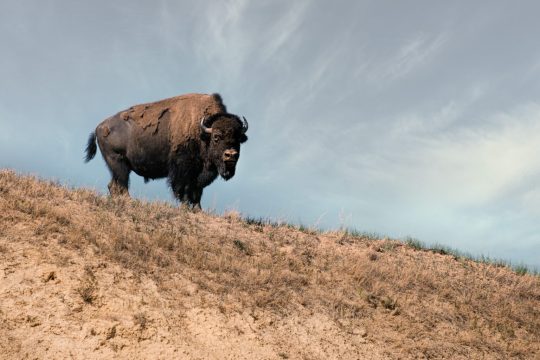
From 1960 to 2016, Eurasian beaver (Castor fiber) populations have ballooned 167-fold, from just a few thousand at the start of the 20th century to over 1.2 million wild beavers today. Grey seal populations have also grown by 6,273 percent and the population of Alpine ibex has risen by 417 percent. Eurasian badger populations have doubled, while Eurasian otter populations have tripled.
While these impressive rates of recovery are not reflected across all of Europe’s 250 wild mammal species, they do provide some evidence-based hope that wild mammals can once again flourish across Europe’s diverse and varied landscapes with the right support and policies in place.
The big picture
... Over the last 50 years the fate of some wild mammals across Europe has shifted. Some populations have experienced a rapid and dramatic increase over the last half century, reversing millenia of decline and offering fresh hope that nature can recover – if it’s given the chance.
Brown bear numbers have risen by an average of 44 percent between 1960 and 2016, while the Iberian lynx has seen its population grow by 252 percent. Humpback whales have seen their numbers rise by 37 percent between 1986 to 2016, while the pine marten – a natural predator to the invasive grey squirrel – has seen its population grow by 21 percent from 1986 to 2016. Some reptile species, such as the loggerhead turtle, have seen its numbers grow by 68 percent over the last 40 years.
The most impressive bounce backs, however, are among the beaver and bison – two species that play vital roles within ecosystems. Both beaver and bison populations have seen 167-fold increases over the last 50 years. These mammals help support a rich mosaic of habitats and biodiversity. Wild bison, for instance, trample and wallow in the soil and sand to create niche habitats for plants, insects and lizards, while also playing an important role in the dispersal of seeds.
Context and background
The impressive recovery rates over the past 50 years have been possible due to a shifting cultural and economic context. Alongside this, there is a growing scientific consensus of the importance of small and large mammals for sustaining biodiversity and helping ecosystems flourish. The sheer diversity of mammals, both in terms of their morphology and their roles within ecosystems, is testimony to the functions they perform. From the tiny bumblebee bat, which weighs just two grams, to behemoth blue whales, weighing in at 150,000 kilograms, mammals really do come in all shapes and sizes.

Wild mammals play a variety of leading roles within an ecosystem, from dispersing seeds, pollinating plants and regulating insect populations, to reducing disease transmission and creating niche habitats for other species. The European bison reintroduced to Kent in the UK have already started clearing paths through undergrowth, ripping the bark off trees, and wallowing around in the mud to make space for seeds and other habitats – natural processes that humans would struggle to replicate. Bison and other large herbivores are often labelled ‘ecosystem engineers’ for this very reason – they shape and manage the land they reside on.
Some species of mammals – such as the magical beaver – are considered keystone species due to their ability to shape the ecosystems around them, creating entirely new habitats through building dams where fish, birds and all manner of species can thrive. Other mammals, like bats, act as indicators of healthy and functioning ecosystems. Between 1974 and 2016, Geoffroy’s bat populations have increased 53-fold across Europe.
Wild mammals also have a role to play in reducing the damage and destruction wrought by climate breakdown. In the temperate climate of Europe, large mammals have been proven to reduce the risk of forest and wildfires by creating gaps in vegetation through grazing and trampling. In the summer of 2022, wildfires ravaged Europe, burning the second-largest area on record. As global temperatures continue to rise, wildfires will increase in their frequency and severity. Bolstering the population of large mammals could provide a useful tool in the fight against fires alongside deep and immediate cuts to emissions...
What’s more, the grazing of wild mammals can also help retain the carbon stability of soil over long periods of time. Soil contains vast amounts of carbon – more than all plants and the atmosphere combined – which makes ensuring its stability important for both climate efforts and environmental conservation. Mammals like the alpine ibex, which have seen their numbers grow by 417 percent from 1975 to 2016, are highly effective at stabilising soil carbon within grazing ecosystems.
-via Rapid Transition Alliance, March 29, 2023
#beaver#bison#mammal#ecosystem#ecology#endangered species#europe#united kingdom#kent#wildfires#rewilding#ecosystem restoration#good news#hope#hope posting
2K notes
·
View notes
Text
Already 3.3 million hectares of land in Canada has been burning because of the extreme heat and dryness and it’s not even halfway through wildfires season. They’re actually predicting this will be the most destructive wildfire season in Canadian history. But most of what I’ve seen posted about these fires has to do with air quality. So I’ve decided to try and compile a list of resources to donate to help Canadians being affected at this time.
Alberta
The Red Cross which seems to have a donation page for most provinces. Both the Canadian and Alberta government will match each dollar of your donation.
Food Banks Alberta helping to feed those affected.
Disaster Aid Canada general help
Atlantic Canada
The Red Cross which if you donate to both the Canadian and the Nova Scotia government will match each dollar of your donation.
British Columbia
United Way BC supporting communities by giving them things such as food, mental health support, and shelter.
Food banks BC helping to feed those affected.
Canada as a whole
Unite for Change not directly donating to the fires but is working to make changes at a provincial and federal level to help fix the climate crisis which is directly making the fires worse.
Please tell me if you know of any other places taking donations to help either put out the fires or help the people affected. If any of these donation links are also donating to discriminatory policies or such like anti-trans legislation's please inform me so I can remove the link!
Quebec and Ontario links are especially wanted as I couldn't find anything for there and neither could my friend.
#paperuniverse post#canada#canadian politics#politics#wildfires#united states#america#boost#important
4K notes
·
View notes
Text
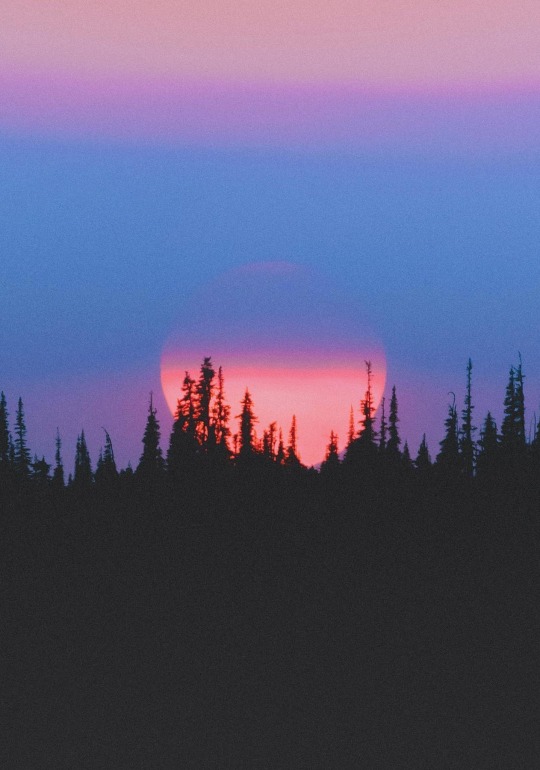
emilie.hofferber
1K notes
·
View notes
Text
Air Quality is 261 now. It was 163 a few hours ago.
Update: it’s 311 now.
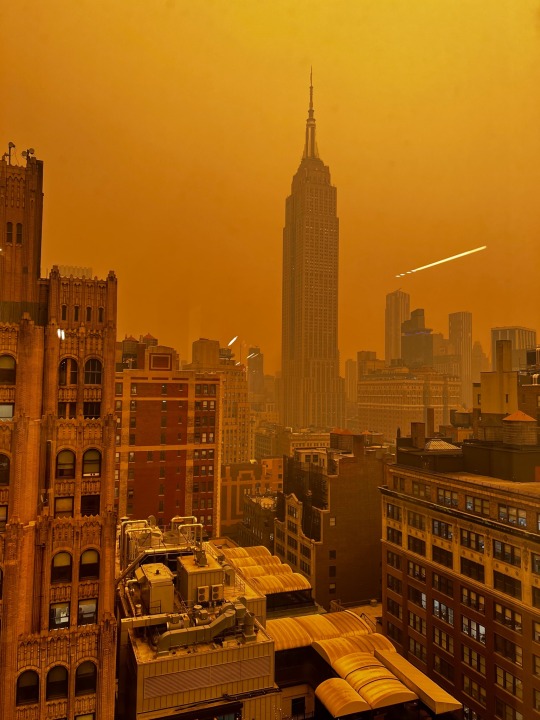

might have to stay inside for real. NY really looked like Roger Deakins was aiming for another Oscar.
#wildfires#nyc#New York#blade runner 2049#roger deakins#there’s a 311 joke in here by accident#Amber is the color of your energy ….#climate change
2K notes
·
View notes
Photo


1K notes
·
View notes
Text



If you are on the East Coast and trying to figure out what all of these air quality warnings mean and what you should do, here is what the colors and corresponding AQI numbers mean. The updated AirNow map is at this link:
Edit: this was posted at 10:50am on June 6 2023 and the screenshots were taken around 9am.
2K notes
·
View notes
Text
INTENTIONALLY TRAPPED Family Escaped Maui Police KILL ZONE By Disobeying Cops, Saw NOTHING On Hwy
If we had a true media this would be the big story.
"I have orders" is NO excuse when you are murdering people.
917 notes
·
View notes
Text
the smoke from the wildfires in canada are crossing the atlantic and is now bringing a haze to the nordic countries
it's said that the soot from the smoke will deposit onto the snow and ice of the arctic which will in turn increase local warming (i.e worst wildfires, ice sheets melting, oceans warming and rising, stronger tropical cyclones, etc. etc.)
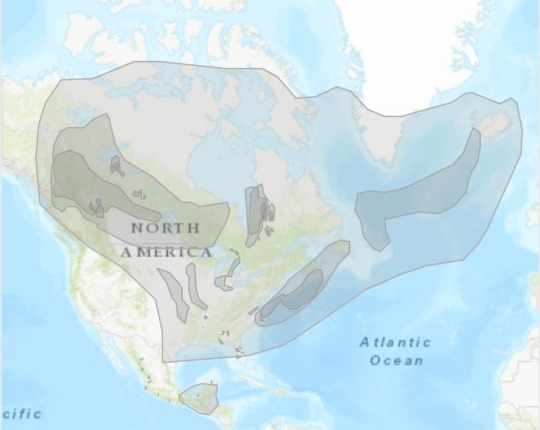
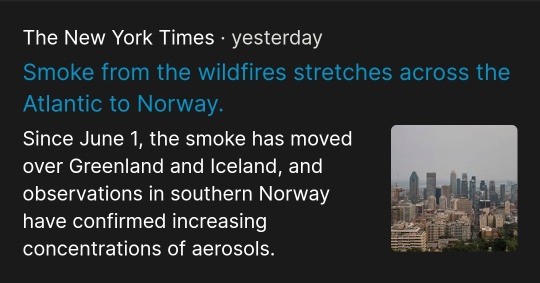
From the NY Times (and other sources):
Ways to Help
The Canadian Red Cross: Every $1 donated to the Canadian Red Cross will become $3 to support those affected by wildfires. The funds will be directed to people living in Nova Scotia and other Atlantic provinces, some of the hardest hit areas, for immediate and ongoing relief and recovery efforts as well as community preparedness initiatives.
United Way: The Canadian federal government joined the government of the Northwest Territories in a similar matching program to support disaster relief and recovery efforts. The funds will be used to support nonprofit community groups who are helping local residents.
Donate a Mask: This volunteer-run charity ships free N95-equivalent masks to anyone in Canada who requests them, with priority to Canadians who cannot afford or do not have access to high-quality masks.
Firefighters Without Borders: This Ontario-based nonprofit donates equipment and training to communities across Canada and in other countries.
Odawa Native Friendship Centre: The Odawa NFC is a nonprofit organization serving the Indigenous community in the Ottawa-Carleton region and is currently collecting donations for First Nation evacuees (with “wildfire evacuees” as the donation type). On Facebook, the NFC noted that it can no longer accept clothing donations.
Canadian Interagency Forest Fire Centre (CIFFC): Live map of the fires. Updated daily.
APTN National News: Newspaper on the Indigenous Peoples of Canada. Can be used to understand how the climate is affecting the Inuit, Métis, and First Nations.
#canadian politics#canadian wildfires#canada#wildfire#wildfires#fire#climate change#environmentalism#mutual aid#mutual assistance#weather#meteorology#academia#studyblr
2K notes
·
View notes
Text
As you may know, wildfires are burning all across Canada right now, especially in Quebec, Alberta, and Nova Scotia. The smoke has spread great distances, even to places where there aren’t currently any fires. Although there are no fires near my city, the landscape has been obscured by a haze, and it feels like I’m inhaling massive amounts of campfire smoke, which most definitely isn’t good for the lungs. My fellow Canadians (as well as American friends along the border), please, please stay safe. Get your news from trusted sources, listen to health advisers and climate experts, stay inside if possible, and consider wearing a mask outside. If you’re in an area that’s been severely impacted by the fires, my heart goes out to you.
1K notes
·
View notes
Text
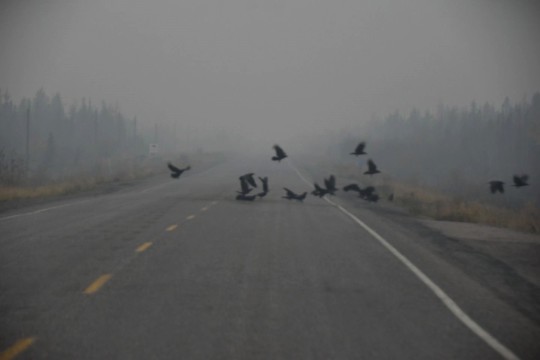
#WelcomeToYellowknife
October 8th, 2023
@BenAdrienProulx
#Welcome to Yellowknife#Ravens#Roadkill#Wildfires#Wildlife Need Protection#IUCN#International Union for Conservation of Nature#ECCC#Environment and Climate Change Canada#FeederWatch#Count Feeder Birds for Science#NCC#Nature Conservancy of Canada#Nature Photography#Nature Canada#Wild Bird Photography#Wildlife Photography#Animal Photography#Mountainous Parts of the Northern Hemisphere#Canada#The RavenKeeper
242 notes
·
View notes
Text

1K notes
·
View notes